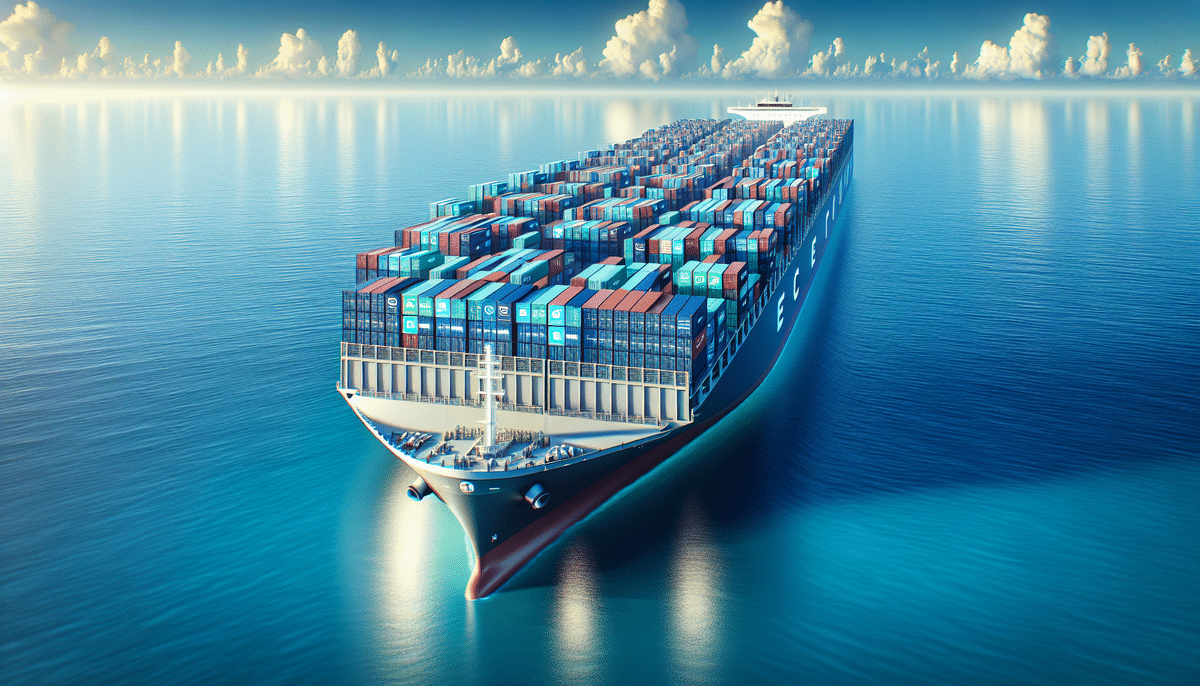Unlocking the Benefits of Ocean Freight for E-Commerce Logistics
In the rapidly evolving world of e-commerce, efficient logistics are crucial for success. Among various shipping options, ocean freight has emerged as a popular choice for many businesses. This article delves into the advantages of using ocean freight for e-commerce logistics, supported by data and insights, and offers tips for integrating it into your logistics strategy.
Why E-Commerce Businesses Should Consider Ocean Freight for Logistics
For e-commerce businesses aiming to reduce costs and enhance efficiency, ocean freight stands out as a viable option. According to the International Air Transport Association (IATA), ocean freight is approximately 60% cheaper than air freight for long-distance shipping. Additionally, it boasts a lower environmental footprint, making it a sustainable choice.
Ocean freight offers substantial capacity, allowing the transportation of larger quantities of goods in a single shipment. This is particularly beneficial for businesses dealing with high volumes or oversized items, enabling economies of scale that reduce per-unit shipping costs.
Reliability is another key advantage. Ocean freight is less susceptible to delays caused by weather or other disruptions compared to air freight. This predictability ensures timely deliveries, which is critical for maintaining customer satisfaction and trust.
Furthermore, ocean freight facilitates access to a global market. With extensive port networks worldwide, e-commerce businesses can expand their reach, tapping into new customer bases and increasing sales potential.
The Advantages of Using Ocean Freight in E-Commerce Logistics
Cost savings are one of the most significant benefits of ocean freight. Businesses can leverage lower shipping rates to enhance their profit margins or offer competitive pricing to customers. Additionally, ocean freight provides greater flexibility in shipping schedules, allowing businesses to optimize inventory management and respond swiftly to market demands.
The capacity of ocean vessels far surpasses that of air or road transportation. This means businesses can ship larger volumes at once, reducing the number of shipments needed and further lowering costs. For instance, a single container ship can carry up to 24,000 TEUs (twenty-foot equivalent units), facilitating bulk shipments that are impractical with other modes of transport.
From an environmental perspective, ocean freight is more sustainable compared to air or road transport. The International Maritime Organization (IMO) reports that shipping accounts for about 2-3% of global carbon emissions, significantly lower than air freight’s 12%. This makes ocean freight an environmentally responsible choice for businesses committed to reducing their carbon footprint.
Understanding the Ocean Freight Process for E-Commerce Logistics
The ocean freight process involves several key steps:
- Booking the Shipment: Selecting the right shipping route and carrier to meet your business needs.
- Arranging Transportation: Coordinating the movement of goods from your warehouse to the port of departure.
- Managing Customs Clearance: Ensuring compliance with international trade regulations and timely clearance through customs.
Working with a reputable shipping provider ensures that each step is handled efficiently. Understanding the regulations and potential risks, such as delays due to port congestion or customs inspections, is crucial for smooth operations.
To mitigate risks of delays, businesses should develop contingency plans and maintain open communication with their shipping providers. Utilizing real-time tracking systems can help monitor shipments and address any issues promptly.
How to Choose the Right Ocean Freight Provider for Your E-Commerce Business
Selecting the appropriate ocean freight provider is vital for the safety and timeliness of your shipments. Key factors to consider include:
- Experience and Expertise: Providers with extensive experience in e-commerce logistics can offer tailored solutions.
- Reputation: Look for providers with strong reviews and a track record of reliability.
- On-Time Delivery: Ensure the provider has a high rate of timely deliveries.
- Customer Service: Effective communication and support are essential for resolving any issues that may arise.
- Pricing: Competitive rates without compromising on service quality.
Additionally, the ability to handle unexpected challenges, such as port delays or customs issues, is crucial. Providers offering real-time tracking and robust support networks can provide peace of mind and ensure your logistics operations run smoothly.
Cost-Saving Benefits of Ocean Freight in E-Commerce Logistics
Ocean freight offers substantial cost savings compared to other transportation modes. Businesses can reduce shipping costs by up to 70% when opting for ocean freight over air freight, according to the International Monetary Fund (IMF).
Moreover, the flexibility in shipping schedules allows businesses to plan shipments more efficiently, reducing the need for expedited shipping and further cutting costs. Optimized inventory management supported by reliable ocean freight schedules can lead to significant savings.
Environmentally, ocean freight is a greener alternative, producing approximately 0.01 kilograms of CO2 per ton-kilometer, compared to 0.5 kilograms for air freight. This reduction in emissions not only benefits the planet but also aligns with the growing consumer demand for sustainable business practices.
The Environmental Impact of Choosing Ocean Freight for E-Commerce Logistics
Ocean freight is a more sustainable transport option, contributing to lower carbon emissions. The International Maritime Organization (IMO) has set targets to reduce greenhouse gas emissions from shipping by at least 50% by 2050 compared to 2008 levels, emphasizing the industry's shift towards greener practices.
Ships are designed to withstand harsh conditions and equipped with advanced safety measures to minimize accidents and spills. However, in the event of a spill, the environmental impact can be severe, affecting marine life and ecosystems. Therefore, adherence to strict environmental regulations and safety protocols is essential.
Economically, ocean freight allows businesses to save on transportation costs, thereby increasing profit margins. Even though shipping times may be longer than air freight, the cost benefits and sustainability factors often outweigh the disadvantages for many e-commerce businesses.
Common Challenges and Solutions When Using Ocean Freight in E-Commerce Logistics
Despite its advantages, ocean freight presents certain challenges:
- Customs Clearance: Navigating the complexities of international regulations can be daunting.
- Delays: Factors like weather, port congestion, and customs inspections can impact delivery times.
- Damage or Loss of Goods: Ensuring the safe handling of goods during transit is critical.
- Coordinating Multiple Shipments: Managing shipments from various suppliers can be complex.
Solutions to these challenges include partnering with experienced freight forwarders or third-party logistics providers who can manage customs clearance and coordinate shipments efficiently. Implementing robust tracking systems can help monitor shipments in real-time, allowing businesses to address delays promptly. Additionally, optimizing packaging to protect goods during transit can reduce the risk of damage or loss.
Best Practices for Integrating Ocean Freight into Your E-Commerce Logistics Strategy
To effectively incorporate ocean freight into your logistics strategy, consider the following best practices:
- Partner with a Reputable Shipping Provider: Choose a provider with proven expertise in e-commerce logistics.
- Understand the Ocean Freight Process: Familiarize yourself with the steps involved and the associated regulations.
- Implement Tracking and Monitoring Systems: Use technology to track shipments and ensure timely deliveries.
- Optimize Packaging: Use durable materials and efficient packaging techniques to protect goods and reduce shipping costs.
- Plan for Contingencies: Develop backup plans to handle unexpected delays or issues.
By adhering to these best practices, businesses can maximize the benefits of ocean freight while minimizing potential drawbacks.
Case Studies: Successful Integration of Ocean Freight in E-Commerce Logistics by Leading Brands
Several leading e-commerce brands have successfully integrated ocean freight into their logistics operations:
- Amazon: Amazon has leveraged ocean freight to streamline its supply chain, reducing shipping costs by 30% and improving delivery times. This integration has been pivotal in maintaining Amazon’s competitive edge in the market.
- Alibaba: Alibaba has expanded its global footprint by utilizing ocean freight, enabling it to reach new markets efficiently. This strategic move has enhanced Alibaba’s supply chain efficiency and contributed to significant revenue growth.
These case studies highlight how ocean freight can be effectively integrated into large-scale logistics operations, yielding substantial benefits in terms of cost savings and operational efficiency.
Future Trends and Opportunities in Using Ocean Freight for E-Commerce Logistics
The future of ocean freight in e-commerce logistics is promising, with several emerging trends and opportunities:
- Digitalization and Automation: Advanced technologies like blockchain and IoT are enhancing transparency and efficiency in ocean freight operations.
- Sustainability Initiatives: Increasing emphasis on green shipping practices is driving innovations in fuel efficiency and emission reduction.
- Integration with Multimodal Transport: Combining ocean freight with other transportation modes can optimize supply chains and improve delivery times.
- Advanced Tracking Solutions: Enhanced real-time tracking and data analytics are providing businesses with better visibility and control over their shipments.
Adopting these trends can help e-commerce businesses stay ahead of the competition and continually improve their logistics strategies.
Conclusion
Ocean freight presents a compelling option for e-commerce businesses seeking to reduce costs, enhance efficiency, and adopt sustainable practices. By partnering with reputable shipping providers and implementing effective tracking and monitoring systems, businesses can ensure the safe and timely delivery of their goods. Embracing future trends and best practices will further enable businesses to optimize their logistics strategies, maintain competitiveness, and achieve long-term success in the dynamic e-commerce landscape.






















